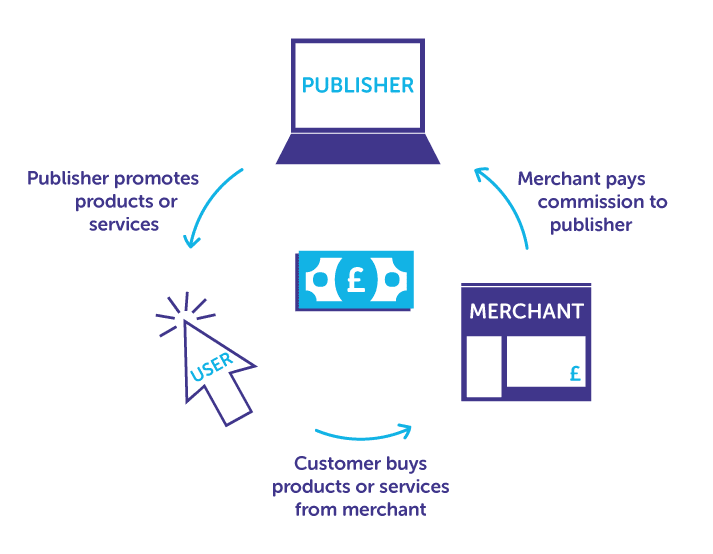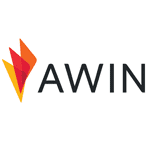Keen to learn more about affiliate marketing? Read on to discover what it is, how it works, how to maximise your profits and which affiliate networks to use.
Credit: Prostock-studio, Linda Bestwick – Shutterstock
Affiliate marketing is a brilliant way to make money online. But, as it's such a huge topic, you won't be alone in wondering how to get started.
To simplify the whole process, we've condensed it down to the need-to-know facts. By the time you've reached the end of this page, you'll have the knowledge you need to start earning a passive income as an affiliate marketer.
Affiliate marketing
What is affiliate marketing?
Affiliate marketing is a way to make money online by recommending products or services to others.
When affiliate agreements are in place, you can earn a commission each time someone makes a purchase or sign-up based on your suggestions. It can involve almost anything sold online, such as physical goods or digital products and services.
For example, Amazon has an affiliate programme (more info about this here). If you've joined the programme and you recommend any products from Amazon, you can quickly add an affiliate link to your site. When somebody clicks the link and buys something, you get paid a commission.
You can also make money by promoting Amazon Prime and other subscription services.

If you're unfamiliar with affiliate links, don't worry as we'll explain them shortly.
Who is involved in an affiliate contract?
The two key players in an affiliate agreement are the publisher and the merchant (sometimes called the 'advertiser').
Here's a quick explanation of what's meant by a publisher and a merchant in affiliate contracts.
Publisher
The publisher is the person/organisation who is promoting the product or service. This could be on their website, newsletter, social media or anywhere else online.
We're an example of a publisher. Sometimes, merchants give us affiliate links that we include in our online content.
When people click on affiliate links, publishers can earn a commission, such as if anyone goes on to buy an item or sign up for a service.
Merchant
The merchant is the company that's being promoted in the publisher's content. You might also hear them referred to as the advertiser, the retailer, the seller or something similar.
Some examples of merchants are ASOS, Hobbycraft, Wilko, Booking.com and Amazon. Any company that sells a product or service could enter into an affiliate agreement as a merchant.
Merchants give the affiliate link to the publisher and will pay them a commission based on the terms of the affiliate contract.
Affiliate networks often act as the middle person, facilitating the agreements between publishers and merchants. Find out more about the top networks, and how they each work, here.
Affiliate links
An affiliate link is a URL for a merchant's website that includes information to identify the publisher as the source of the visit.
From the perspective of the person clicking the link, the fact that it's affiliate won't impact them. If they go on to buy something from the merchant's site, it won't cost them any more money than it would have otherwise.
The commission is paid by the merchant to the publisher.
In fact, some affiliate links offer shoppers a discount at the checkout. So, those making the purchase could actually save money.
What does an affiliate link look like?
Affiliate links usually include direct links within them, but they also tend to have added info that identifies the affiliate network it was from, the publisher's ID number and the merchant's ID number.
Direct links are usually structured like this:
- https://www. [merchant name] .co.uk
Whereas an affiliate link could look something like this:
- https:// [affiliate network URL] ? [publisher ID = reference number] & [merchant ID = reference number] & URL = https://www. [merchant name] .co.uk
These are very general guidelines. You'll often find that affiliate links differ depending on which network they're from. For example, a link from Awin will look different to a link from Amazon Associates.
But, regardless of how the affiliate link is structured, there will be at least one ID code within it to track a site visit back to the publisher.
When you click an affiliate link, you'll be redirected to a new URL. If you ever want to see the redirects broken down step-by-step, try using a tool like Redirect Detective.
Different ways to earn commission

The way that you'll earn commission as an affiliate marketer will vary depending on what is being marketed.
Here are the main ways you can earn commission:
- Cost per lead (CPL) – Also known as 'lead generation', CPL is where a merchant pays for sign-ups to their site/service.
- Cost per click (CPC) – As the name suggests, CPC is an advertising model that pays for each click that a link receives.
- Cost per action (CPA) – CPA marketing is where you earn a commission based on a customer completing a certain action. Common examples are if they purchase a product or fill in a form.
- Lifetime revenue share (RevShare) – Lifetime RevShare marketing lets you earn a percentage of the overall revenue someone will bring during the whole time they're a customer.
- Percentage of fixed amounts – This is where you earn a percentage of a pre-determined amount of money.
We have a step-by-step guide that explains how to create a website in 20 minutes.
How to start affiliate marketing
Here are the top ways to start affiliate marketing:
-
Create a website
When becoming an affiliate marketer, the first step is to start your own website.
As we'll explain more in the next point, with a website, you'll have the chance to bring in steady traffic each day if your content ranks well on search engines. And with steady traffic, you can earn a steady income from affiliate links.
However, while a website is a great way to make money with this form of marketing, there are other options too. You can also make money by using affiliate links on additional online platforms, like on social media and in newsletters (more on this here).
Whichever platform you post affiliate links on, indicate somewhere that you could earn a commission. This could be as a disclaimer on your site, or by including 'AD' in the caption of a social media post. See the ASA's guide for influencers for more info.
-
Generate traffic to your website
To make money from affiliate marketing, you need people to read your content and click the links. So, to monetise your website, it's essential to bring in site traffic.
Start by writing content so there's something for people to read when they visit your site. It should be accurate, engaging and useful for readers.
And then, after taking some time to write and publish high-quality content, try to find readers. You can do this by sharing your articles on social media and through search engine optimisation (SEO).
What is SEO?
SEO refers to the ways that websites optimise their on-site content to help it rank on search engines like Google. The higher the content ranks for key search phrases, the more views it will get.
On a basic level, SEO involves keyword research. To start off, think about words and phrases that you want your content to rank for, and integrate them into the content.
As we said, though, that's SEO at a basic level. As you learn more about it, you'll discover there's a lot more to it than that.
It's such a valuable skill in digital content writing/editing. Take the time to learn more about it and develop advanced SEO skills. It could really help you achieve affiliate marketing success.
A good starting point is Google's SEO Starter Guide. There are also loads of online courses that cover SEO basics (try to find free ones if possible).
-
Start a mailing list

Credit: Marie Maerz – Shutterstock
To build an audience as a new affiliate marketer, it's worth creating a mailing list and sending out regular, informative newsletters.
You could simplify the process of email marketing by using a tool like AWeber. They have a free plan for newsletters with up to 500 email subscribers.
If you have more subscribers than that, or you're keen to use some advanced features, their Pro plan might be more suited to you. At the time of writing, prices start at $16.15 per month (around £12.50).
You can find out more on AWeber's website.
A couple of alternative email marketing platforms are Mailchimp and Cakemail. Both of these offer tools that help you manage and grow your mailing lists. Visit their websites to find out more about their marketing features and pricing.
-
Sign up to affiliate networks
Once you've built up a loyal audience for your website, you'll be ready to sign up for affiliate networks.
We go through eight of the best affiliate networks here. They don't all operate in quite the same way, but our descriptions of each affiliate network below cover their key differences.
To join networks, you'll usually need to provide details of your website/online platform. Then, if and when you're accepted, you'll be able to get affiliate links for merchants from that network.
It makes a big difference to build and foster relationships with account managers at the networks.
They know what works best and will have loads of experience, both in the technical and commercial sides of affiliate marketing. And ultimately, they want you to succeed. If you have any questions, they're great people to ask.
-
Arrange affiliate agreements with individual companies
Sometimes, to set up an affiliate agreement, you'll need to contact a company directly.
Here are some examples of when this might be the case:
- The merchant isn't part of an affiliate network
- The merchant is part of a network but is hidden when you search for them
- You want to make a tailored agreement with them (e.g. to arrange certain conditions or negotiate higher commission rates)
- You've applied to join a merchant's affiliate programme via a network, but they're taking a long time to approve you.
In our last point, we explained how important it is to build strong relationships with your contacts at affiliate networks. The same applies when working with individual companies.
It helps if you and your contact at the company (usually an affiliate/marketing manager) work well together. Remember that they, like you, want the affiliate contract to be a success.
-
Write high-quality content for affiliate marketing success

We mentioned earlier that writing strong content is important from an SEO perspective. But you shouldn't just consider how to get people onto the page – think about how they'll respond to your content once they're there.
For a reader to buy something or sign up for a service based on your recommendation, they need to believe in you and your authority on the subject. Only use affiliate links for products or services that you genuinely recommend. If you believe in the thing you're promoting, this will come across to the reader.
A good way to increase the click-through rate (CTR) of an affiliate link is to write a tutorial that explains how to do something using that product or service. This way, the reader can find out more about its benefits and gain an insight into what they'd get for their money.
For example, if you're recommending a particular mobile phone, you could write a how-to guide that focuses on one of its top features. It might have a great camera, in which case you could explain how to take high-quality photos with it.
When writing walkthrough guides, be honest and cover both the pros and cons of the product. This way, readers will know they can trust your review, and it'll help them decide if they should make the purchase.
-
Monitor your earnings from affiliate marketing
Affiliate networks will generally make it easy for you to keep track of how much money you've made through them. Usually, when you sign in to your account on a network's website, you'll see an overview of your earnings on a dashboard.
If you've signed up to multiple networks, it can get a bit harder to keep track of them all.
A spreadsheet will help. On there, you can include the earnings from each network, as well as the money made from every individual company you have an agreement with.
Try to get into the habit of updating the spreadsheet regularly, such as on a weekly or monthly basis. This way, you'll know exactly how much money you're making.
-
Look out for changes to affiliate agreements
Companies sometimes decide to end their affiliate agreements for any number of reasons.
Or, you might find that an affiliate agreement is still ongoing, but the terms have changed, like an alteration to the commission rates.
Changes to affiliate rates are usually notified via email. So, to stay informed, make sure you opt in for network updates.
Keep an eye out for any changes – especially in case an affiliate link on your site stops working.
It's important to regularly review your site's broken links report. This will help you quickly identify when you need to change or remove an affiliate link.
Cashback sites are great examples of companies that make money with affiliate marketing.
8 best affiliate networks
Here are the top affiliate networks:
-
Awin
Best features: Great range of popular advertisers; detailed reports and insights about earnings; easy-to-use Google Chrome plugin.
Awin is a huge affiliate network, and it's a really simple one to use as a publisher.
They have a wide range of popular merchants in their network. At the time of writing, this includes ASOS, O2, Currys PC World, British Gas, lastminute.com and many more.
It speeds up the process of getting affiliate links if you use the MyAwin plugin for Google Chrome. With this, anytime you visit a website, you'll quickly see whether it's part of the Awin network.
If a site's part of the network but you don't yet have an affiliate agreement set up with them, the plugin's icon will have an orange square beside it. If you click the icon, you'll see a button that says 'Join this advertiser'. After clicking this, you'll be taken to a page where you can apply to form an affiliate agreement with that company.
If you visit a website and you notice a green square by the MyAwin icon, you'll be able to get an affiliate link immediately. All you need to do is click the icon, and then press 'Generate tracking link' – and as easy as that, you'll receive the link.
-
impact.com
Best features: Good range of global advertisers; exclusive promo codes for publishers; customisable and streamlined contracting process.
impact.com has really some big-name brands, such as adidas, Airbnb, Revolut and Lenovo.
To maximise your earnings, sign up to as many affiliate networks as you can as some brands will advertise via one network, but not another. As an example, adidas isn't on Awin, so if you're keen to promote them, join impact.com.
-
Rakuten Advertising
Best features: Advanced analytics; big global network; easy sign-ups.
Rakuten Advertising is one of the biggest affiliate networks. Among their advertisers are Whistles, Molton Brown and Mountain Warehouse.
It's usually pretty easy to sign up with advertisers via Rakuten Advertising. On the whole, you'll need to apply for affiliate links directly through them.
However, sometimes when retailers are part of this network, they'll have a link on their site that takes you to a sign-up page. Once there, you can log in to your Rakuten Advertising account and apply to join the merchant's affiliate programme.
-
CJ
Best features: Detailed analytics; global brands; Content Certification programme (if eligible).
CJ (previously known as Commission Junction), is another major affiliate network. Their advertisers include IHG Hotels & Resorts, J.Crew, Barnes & Noble and more.
They're particularly geared up for US and Canadian publishers and advertisers. But if you're based in the UK or elsewhere, it could still be worth signing up.
As we mentioned earlier, some networks have advertisers that you can't find anywhere else, so the more networks you join, the better.
If you happen to have your primary traffic coming from the US or Canada and you have over 10,000 page views a month, you might qualify for the Content Certification programme. This lets you automatically connect with over 600 big brands.
Find out more about Content Certification, including the full eligibility criteria, here.
-
Amazon Associates
Best features: Quick access to deep affiliate links for Amazon; on-screen SiteStripe banner.
Amazon Associates makes it incredibly easy to get affiliate links for Amazon products. You can get deep links immediately for any product page or search results page on Amazon.
In case you're unfamiliar with deep links, they're affiliate links that go to a specific page on a site, rather than the homepage. So if you have an affiliate link going to a particular product listing, this would be a deep link.
Once you've joined this network as a publisher, a banner (or a 'SiteStripe' as Amazon calls it) will appear at the top of the page whenever you're on the Amazon website. To get an affiliate link for the page you're on, simply click 'Text' under where it says 'Get Link:' on the banner, and the affiliate link will appear!
The next three networks operate slightly differently. Have a read of the descriptions for an overview of how they each work.
-
digidip
Best features: Affiliate links for brands from various networks; automated affiliate links.
As well as joining the above networks, you can also sign up to digidip as a publisher.
They search through multiple affiliate networks to help you find affiliate links for brands. This is very useful if you don't know which network a brand is with.
Compared to going direct through another affiliate network, you could potentially receive less commission through digidip. But, equally, there's also the chance that you can earn more.
As such, even if you're able to get an affiliate link from a network, it can still help to check on digidip too in case you're able to earn a higher commission.
digidip also has a service that automatically converts product links into affiliate links throughout your website. Find out more in their T&Cs.
-
Skimlinks
Best features: Affiliate links for brands from various networks; automated affiliate links.
Skimlinks works in a similar way to digidip. They help you find affiliate links for brands, even if you don't know which network they're with. Again, this is such a useful service for publishers.
Similarly to digidips, Skimlinks also has a link automation tool which can turn the product links on your site into affiliate ones.
-
Sovrn
Best features: Automated affiliate links.
With Sovrn, a key feature is its content monetisation tool. And, like with digidip and Skimlinks, this tool can be automated across your site.
It turns current product links into affiliate ones, and also searches for key product/merchant names to identify where you can add more links.
If, say, you mention a particular make of phone within your online copy, Sovrn could add an affiliate link to this.
With Sovrn, you can make money through CPA or CPC marketing, depending on which is better suited to your content. Head to their website to find out more.
Now you've read this, it's time to start making money from your website.















